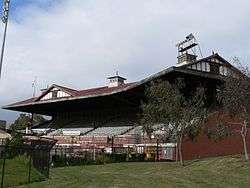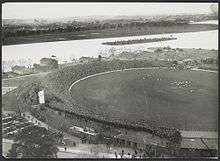Lakeside Stadium
  | |
| Former names | Lake Oval, South Melbourne Cricket Ground, Bob Jane Stadium |
|---|---|
| Location | Aughtie Drive, Albert Park, Victoria |
| Coordinates | 37°50′25″S 144°57′54″E / 37.84028°S 144.96500°ECoordinates: 37°50′25″S 144°57′54″E / 37.84028°S 144.96500°E |
| Operator | State Sports Centre Trust |
| Capacity | 12,000 (7,400 seated)[1] |
| Surface | Grass (soccer stadium), blue synthetic (athletics track) |
| Construction | |
| Broke ground | 1876 |
| Opened | 1878 |
| Renovated | 1995, 2011 |
| Tenants | |
|
South Melbourne FC | |
Lakeside Stadium is a sports arena in Albert Park, Melbourne, Australia. Comprising an athletics track and soccer stadium, it currently serves as the home ground and administrative base for the South Melbourne FC, Athletics Victoria, Athletics Australia, Victorian Institute of Sport and Australian Little Athletics.
The venue was built on the site of the former Australian rules football and cricket ground, Lake Oval (or South Melbourne Cricket Ground). It served for more than a century as the home ground of the South Melbourne Football Club and the South Melbourne Cricket Club, although it was also used for soccer from at least 1883.[2]
It is one of four sporting facilities in Melbourne - the others being the Melbourne Sports and Aquatic Centre (MSAC), the MSAC Institute of Training (MIT) and the State Netball and Hockey Centre (SNHC) - to be organised under the banner of Melbourne Sports Hub.
History
The Lake Oval and Australian rules football

In its original oval configuration, the Lake Oval served most prominently as the home ground for Australian rules football club South Melbourne, in both the Victorian Football Association and the Victorian Football League. In its early days, the ground was considered one of the best in the league, and was the venue for the 1901 VFL Grand Final. South Melbourne used the ground for home games until the end of the 1981 VFL season, when the club relocated to Sydney and became the Sydney Swans. The last senior VFL match played at Lake Oval was on Saturday, 29 August 1981, when South Melbourne was defeated by 33 points against North Melbourne in front of 8484 fans. The club continued to use Lake Oval for reserves matches for several years after 1981.
When electric floodlighting was installed at the venue during the 1950s, it became one of the first venues in Melbourne to regularly host night football matches, including the night premiership series between 1956 and 1971. Night premiership matches in the Victorian Football Association in 1957 and 1958[3] and night interstate matches,[4] including many matches at the 1958 Interstate Carnival[5] were also held at the Lake Oval.
The ground record crowd for Lake Oval was set on 30 July 1932 when 41,000 turned out to see Carlton defeat South Melbourne by nine points.[6]

For a time during the late 1980s and early 1990s, the struggling Fitzroy Football Club used the ground as a training and administrative base.[7] The Old Xaverians Football Club of the Victorian Amateur Football Association was based there in 1993 and 1994. The oval was home to the South Melbourne Cricket Club during the summer.
A remnant of the old Lake Oval structure, a grandstand built in 1926, still remains standing at the venue. It had not been used for several years, and had fallen into disrepair. Its continued existence was the subject of debate. At one stage the Sydney Swans football club showed interest in repurchasing it to be used as a museum and administrative building, while there were also calls from others to demolish the building because of its derelict state. Under the re-modelling of the venue in 2011, the stand was refurbished to house the VIS.[8]
Redevelopment
Revelopment of the venue from an oval football/cricket stadium to the rectangular football stadium which became known as the Lakeside Stadium took place in 1995, when South Melbourne FC was forced out of its old home at Middle Park.[9] The stadium was built with a capacity of 14,000 people,[10] which was achieved or approached several times in South Melbourne's history at the ground. A grandstand with an approximate capacity of 3,000 people was situated on one side, with a social club, reception centre and administrative facilities built in, while the other three sides of the ground consisted of open terraces with wooden seats. At one stage, a second two tiered stand for the outer side was proposed, but only preliminary plans were produced.[11]
As well as being the home of South Melbourne FC, the venue also hosted games by the Socceroos,[12] Young Socceroos, Australia's national women's team the Matildas,[13] and grand finals and finals matches of the Victorian Premier League (now National Premier Leagues Victoria).[14]
Athletics venue
In May 2008, the State Government announced that Lakeside Stadium would undergo a major redevelopment, in order to accommodate an athletics track, as part of moving Athletics Victoria from Olympic Park. The Victorian Institute of Sport, Athletics Victoria and South Melbourne FC would share tenancy of the venue. Major Projects Victoria committed $60 million to the project. South Melbourne played its final match under Lakeside Stadium's previous configuration in April 2010, and construction work on the remodelled venue began in June 2010.
The synthetic 8-lane athletics track was constructed to international IAAF standards. A 6-lane 60 metre warm-up track was also constructed. The remodelling also saw a FIFA-sized natural grass soccer pitch, a new electronic scoreboard, upgraded lighting, a new northern stand and new spectator amenities. The old grandstand was also renovated to accommodate offices.[15] In March 2012, the stadium hosted the Melbourne Track Classic.
The venue is operated by the State Sports Centre Trust, the operators of the Melbourne Sports and Aquatic Centre and the State Netball and Hockey Centre.
See also
- Middle Park (stadium)
- List of Australian rules football statues, a list of Australian rules football-related statues across Australia
References
- ↑ "Lakeside Stadium". South Melbourne FC. Retrieved 5 July 2017.
- ↑ Syson, Ian (30 September 2013). "Victorian Soccer Fixtures and Results 1883". Neos Osmos. Retrieved 24 June 2016.
- ↑ "Lone V.F.A. club's 'no' to night football". The Sun News-Pictorial. Melbourne. 2 April 1957. p. 47.
- ↑ Carrick, Noel (24 July 1957). "Burst by S.A. crushes V.F.A.". The Sun News-Pictorial. Melbourne. p. 45.
- ↑ Bretland, Bernie (3 July 1958). "Big men pave way for WA". The Sun News-Pictorial. Melbourne. p. 38.
- ↑ "Lake Oval - Attendances (1921-1981)". AFL Tables. Retrieved 5 July 2017.
- ↑ Linnell, Stephen (23 July 1993). "Lion members back move to Western Oval". The Age. Melbourne. p. 28. Retrieved 5 July 2017.
- ↑ "State Sports Facilities Project". Major Projects Victoria. Archived from the original on 22 April 2011. Retrieved 5 July 2017.
- ↑ Keyte, Jennifer (presenter); Donahoe, Brendan (reporter) (29 May 1994). "Albert Park - The Track". Seven Nightly News. Seven Network. HSV Melbourne. Retrieved 5 July 2017 – via Argiri on YouTube.
- ↑ "Lakeside Stadium". Austadiums. Retrieved 5 July 2017.
- ↑ "Bob Jane Stadium Redevelopment". Austadiums. Archived from the original on 17 May 2008. Retrieved 5 July 2017.
- ↑ Esamie, Thomas; Stock, Greg; Cazal, Jean-Michel; Scicluna, Frank. "Socceroo Internationals for 1996". OzFootball. Retrieved 5 July 2017.
- ↑ Esamie, Thomas. "Matildas Internationals for 2006". OzFootball. Retrieved 5 July 2017.
- ↑ Punshon, John. "2006 Vodafone Cup Results". OzFootball. Retrieved 5 July 2017.
- ↑ "State Sports Facilities Project Profile" (PDF). Melbourne Sports and Aquatic Centre.
External links
| Wikimedia Commons has media related to Lakeside Stadium. |
- Lakeside Stadium homepage
- Lakeside Stadium at Austadiums
- "Around the Grounds" - Web Documentary - Lakeside Oval